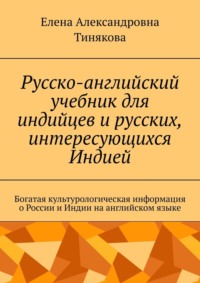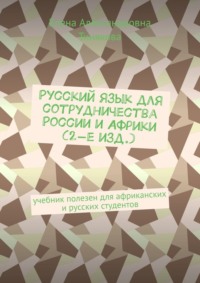
Полная версия
Учебник русского языка для индийцев через посредство английского языка
Стилистика, как ветвь обучения русскому языку, отдельно не представлена. Потому что это уже более высокий уровень приобретения лингвистического опыта. Однако, чтение культурологических текстов может дать некоторый опыт.
И в заключение автор даёт три совета по интенсификации памяти при изучении русского языка. Это неожиданность, естественность и быстрота. «Неожиданность» предполагает вспоминать усваиваемый материал в неподготовленной ситуации. «Естественность» должна давать оттенок свободы воспроизведения, то есть применение без напряжения, как в обычных условиях разговора, пользования русским языком. «Быстрота» должна тренировать на как можно скорое извлечение из памяти того, что изучено.
При соблюдении этих трёх правил успех коммуникации на русском языке обеспечен, его объём только будет зависеть от количества усвоенной лексики.
Отличие методики русского автора от международных, более британских методик, преподавания английского языка в том, что тренировка языка не размельчена на многочисленные упражнения, которые идут от инициативы преподавателя. Русский автор представляет безошибочное употребление русского языка грамматическим, фонетическими схемами, логически организованными, а изучающий сам может придумывать себе различные упражнения. То есть инициатива учащегося не загружена упражнениями учителя, безусловно, упражнения русский автор даёт. И главное – решается труднейшая проблема обучения неродному языку: соответствие смысловых полей лексических единиц. Студент может сравнить одновариантный перевод слова в прилагаемом к тексту словаре с нахождением в переводе текста целиком—могут быть различия.
2. Methodical recommendations
The method of including the student into learning Russian sets the task to bring it to the wide space of the Russian language through the presentation of the key characteristics of the Russian language. This explains the new genre of the textbook – «a textbook with a culturological application», that is, the support of the practice of mastering the Russian language by a large culturological block, including the geographical and administrative representation of Russia, literature, painting and music from the depths of history. The textbook combines Russian language teaching and intensive acquaintance with Russian culture.
The practical side of learning the Russian language corresponds to the basic linguistic sciences: phonetics and orthoepy, morphology and partly spelling, syntax, punctuation. The culturological block also introduces Russian lexicography, that is, the types of dictionaries and briefly advises how to use them.
In the section «Introductory Course of Phonetics» the author compared variantsand explained options for representing the sounds of the Russian language by sings of Latin transcription. Here you need to pay attention to the Latin transcription recommended by the author. It is more exact to differentiate sounds that are difficult for foreigners to pronounce – Е,Ё,Я,Ю,И,Э and Й. Confusion in the use of Latin signs by linguists – J and Y – can interfere with the memorization of words. In a word, the presentation of the phonetics of the Russian language sets the goal to reduce the foreign accent tominimum when pronouncing Russian words and phrases. For this, tongue twisters, reading rules are given, and at the end of the book, proverbs, that is, firmly constructed phrases. With regard to orthoepy, the author teaches to focus the accent by loud oral pronunciation of a wordor consult the dictionary. And after enough practice, the stress in Russian words is already determined by the «sense of language», that is, it does not come from the rules. And it lends itself to a synergistic reception, that is, «self-setting».
The morphology is given in a short, basic way. The author of the book tries to load the learners with rules as little as possible, and think more by analogy from typical examples. After this, we can say «matrix representation of Russian grammar», there is a transition to short texts. And if the texts of culture studies are accompanied by translation (here, too, a combination of the translation of a fragment of the text and the submission of words for independent translation into Russian is used), short thematic texts are offered for understanding through application of words and phrases to translate the text. These texts establish the main thematic layers for everyday conversation. It is better to memorize them. And then repeat the sentences in a different order, changing for a possible projected situation. Words for short thematic texts are given in their original form. Therefore, Russian language learners can compare these original forms with those in the texts, and accompany this comparison with the rules from the Chapter on the basics of grammar.
Colloquial phrases are also offered for communicative situations. They are certainly best learned by heart. To strengthen memory, so that it is not just mechanical, in the construction of phrases, one must see the presented grammar. As you can understand, Russian grammar is given not from theoretical foundations, but from practical experience.
Stylistics, as a branch of teaching the Russian language, is not presented separately. Because this is a higher level of acquiring linguistic experience. However, reading texts with cultural information can provide some experience.
And in conclusion, the author gives three tips for intensifying memory when learning Russian. This is surprise, naturalness and speed. «Unexpectedness (surprise) ” involves remembering the assimilated material in an unprepared situation. «Naturalness» should give a tinge
of freedom of reproduction, that is, application without tension, as in ordinary conditions of conversation, using the Russian language. «Quickness (speed) ” should train for the quickest possible retrieval from memory of what has been learned.
If these three rules are observed, the success of communication in Russian is ensured, its volume will only depend on the amount of learned vocabulary.
The difference between the methodology of the Russian author and the international, more British, methods of teaching English is that language training is not detailed into numerous exercises that come from the teacher’s initiative. The Russian author presents the unmistakable use of the Russian language by grammatical, phonetic schemes, logically organized, and the student himself can come up with various exercises. That is, the student’s initiative is not loaded with the teacher’s exercises, of course the Russian author gives the exercises. And most importantly, the most difficult problem of teaching a foreign language is being solved: the correspondence of the semantic fields of lexical units. The student can compare the single-variant translation of a word in the list attached to the text with finding the same meanings rendered in the whole text in the translation – there may be differences.
3. Типы словарей русского языка
и как ими пользоваться
3. Types of Russian dictionaries and how to use them
История русских словарей началась ещё в XI веке. Но это был удел малого количества грамотных людей на Руси. В дальнейшем словарное дело развивалось параллельно русского языку, науке и грамотности. XVII считается поворотным в составлении словарей на Руси. Потому что в науку и культуру стали активно входить иностранные языки.
«Словарь Академии Российской», состоявший из 6 томов и выпущенный в 1789—1794 года, считается в русской филологической науке первым собственно академическим словарём русского языка.
В настоящее время в России выпускается много типов словарей. Они соответствуют ветвям науки о языке.
В Толковых словаряхсодержатся основные сведения о грамматической характеристике слова, значении слова, правильном употреблении в тексте; в некоторых толковых словарях делается акцент на словообразование.
Словари синонимовприводят примеры по различению оттенков смысла. Богатстволюбого языка оценивается по синонимам.
Словари антонимовдают слова противоположного значения. Эти словари выполняют как бы балансирование двух начал в языке – положительного и отрицательного.
Словари фразеологизмов помогают понять устойчивые фразы, где значение охватывает не одно слово, а несколько. На другой язык устойчивые фразы переводятся через значение группы слов. Типичный пример – это пословицы. Есть и особые словари пословиц русского языка. Потому что даже не все русские могут понять значение фразеологизмов.
Терминологическиесловари помогают понять профессиональные слова и термины из определённой отрасли знания.
Частотные словари помогают определить наиболее часто употребляемые слова.
Словари неологизмов объясняют появляющиеся новые слова в русском языке. Неологизмы могут появляться на материале
русского языка и входить из иностранных языков в русский язык. Для таких неологизмов из других языков существуют также словари заимствований. Есть ещё словари иностранных слов, то есть это те слова, которые функционируют в русском языке, но они чувствуются «иностранными».
Этимологические словари объясняют историю формирования значений слов. Иногда она в процессе истории меняется. Как случилось со словом «красный», теперь оно имеет два разделённых значения: «красный по цвету» и«праздничный», например, красные дни календаря. А в древности слово «красный» означало «красивый».
Для изучающих русский язык важно знать о словарях омонимов. Омонимы – это слова, похожие по написанию (омографы) или произношению (омофоны). Словари помогут дифференцировать такие похожие слова. Менее похожие слова, которые тоже могут усложнить их дифференциацию в употреблении, – паронимы. Для таких слов есть словари паронимов.
Кто из изучающих русский язык захочет заниматься русской литературой, то они должны знать, что в России составлены словари русских писателей, большинства.
Литературный язык един. Но Россия занимает большую территорию, и в регионах могут быть слова, характерные только для этого региона. В решении этой проблемы помогут диалектные словари. Диалект—это вариант русского языка с некоторыми особенностями в грамматике, лексике и фонетике для данного региона.
Итак, автор перечисляет словари, которые всегда помогут отлично знать русский язык после хорошего усвоения материаланастоящего учебника.
Толковый словарь русского языка
Словарь синонимов
Словарь антонимов
Словарь фразеологизмов
Словарь пословиц
Терминологический словарь (по отрасли науки—медицинский, технический и т.д.)
Частотный словарь
Словарь неологизмов
Словарь устаревших слов
Словарь сокращений
Словообразовательный словарь русского языка (поможет строить русские слова от тех, которые вы знаете – ваш словарный запас увеличится во много раз)
Словарь трудностей русского языка
Словарь заимствований (есть словари заимствований и из других языков)
Словарь иностранных слов
Словарь омонимов
Словарь паронимов
Орфоэпический словарь
Диалектный словарь (есть диалектные словари по регионам)
Словарь А. С. Пушкина (и других русских писателей)
Есть также большое количество кратких словарей вышеперечисленной тематики для школьников.
3. Types of Russian dictionaries and how to use them
The history of Russian dictionaries began in the XIth century. But this was the lot of a small number of literate people in Russia. Thenfuture, vocabulary developedparallel to the Russian language, science and literacy. The XVIIth is considered a turning point incompiling dictionaries in Russia. Because foreign languageswere actively included into science and culture.
«The Dictionary of the Russian Academy», which consisted of 6 volumes and was published in 1789—1794, is considered to be the first proper academic dictionary of the Russian language in Russian philological science.
Nowadays many types of dictionaries are issued in Russia. They correspond to the branches of the science of language.
Explanatory dictionaries contain basic information about the grammatical characteristics of the word, the meaning of the word, the correct use in the text; in some explanatory dictionaries, emphasis is placed on word formation.
Dictionaries of synonyms provide examples for distinguishing shades of meaning. The wealth of any language is assessed by synonyms.
Dictionaries of antonyms give words with opposite meanings. These dictionaries perform balancing of two poles in the language – the positive and the negative.
Dictionaries of phraseological units help to understand stable phrases, where the meaning encompasses not one word, but several. Fixed phrases are translated into another language through the meaning of a group of words. A typical example is proverbs. There are also special dictionaries of Russian proverbs. Because not even all Russians can understand the meaning of phraseological units.
Terminological dictionaries help to understand professional words and terms from a specific field of knowledge.
Frequency dictionaries help to identify the most frequently used words.
Dictionaries of neologisms explain the emerging new words in the Russian language. Neologisms can appear on the material of the Russian language and enter from foreign languagesinto the Russian language. For such neologisms from other languages, there are also loan dictionaries. There are also dictionaries of foreign words, that is, these are the words that function in the Russian language, but Russians feel them as“foreign».
Etymological dictionaries explain the history of the formation of word meanings. Sometimes it changes in the course of history. As happened with the word «red», now it has two separate meanings: «red in color» and «holiday», for example, the red days of the calendar. And in ancient times, the word «red» meant «beautiful».
It is important for learners of the Russian language to know about dictionaries of homonyms. Homonyms are words that are similar in spelling (homographs) or pronunciation (homophones). Dictionaries will help differentiate such similar words. Less similar words, which can also complicate their differentiation in use, are paronyms. For such words, there are dictionaries of paronyms.
Any student of the Russian language who wants to study Russian literature should know that in Russia dictionaries of Russian writers, the majority, have been compiled.
The official literary language is one. But Russia occupies a large territory, and in the regions there may be words that are characteristic only of this region. Dialect dictionaries will help in solving this problem. A dialect is a variant of the Russian language with some peculiarities in grammar, vocabulary and phonetics for a given region.
So, the author lists dictionaries that will always help you to know the Russian language perfectly after a good mastering of the material of this textbook.
Explanatory dictionary of the Russian language
Dictionary of synonyms
Dictionary of antonyms
Dictionary of phraseological units
Dictionary of proverbs
Terminological dictionary (in the field of science – medical, technical, etc.)
Frequency dictionary
Dictionary of neologisms
Dictionary of loan words
Dictionary of obsolete words
Dictionary of abbreviations
Word-formation dictionary of the Russian language (it will help to build Russian words from those that you know, your vocabulary will increase many times)
Dictionary of difficulties of the Russian language
Dictionary of foreign words in the Russian language
Dictionary of homonyms
Dictionary of paronyms
Pronouncing dictionary
Dialect dictionary
Dictionary of A.S. Pushkin (and other Russian writers)
There are also many short dictionaries of the types presented above for school learners.
ГЛАВА 1
«Вхождение в русский язык»
CHAPTER 1. «Entering the Russian language»
1.1. Вводно-фонетический курс (алфавит,
группы букв и звуков, слоги на различение звуков;
правила чтения; об орфоэпии, скороговорки)
1.1. Introductory course of phonetics (alphabet, groups
of letters and sounds, syllables to practice distinguishing sounds; reading rules; about orthoepy, tongue twisters)
РУССКИЙ АЛФАВИТ RUSSIAN ALPHABET
Таблица 1
А Б В Г Д Е Ё Ж
а бэ вэ гэ дэ е ё жэ
З И Й К Л М Н О
зэ и и краткое ка эль эм эн о
П Р С Т У Ф Х Ц
пэ эр эс тэ у эф ха цэ
Ч Ш Щ Ъ Ы Ь
че ша ща твёрдый знак ы мягкий знак
Э Ю Я
э ю я
Знаки Ъ и Ь не произносятся. Но влияют на смысл слова.
The signs Ъ and Ь are not pronounced. But they influence the meaning of the word.
Русский алфавит с рекомендуемой транскрипцией латиницей
Russian alphabet with recommended transcription in Latin
Таблица 2
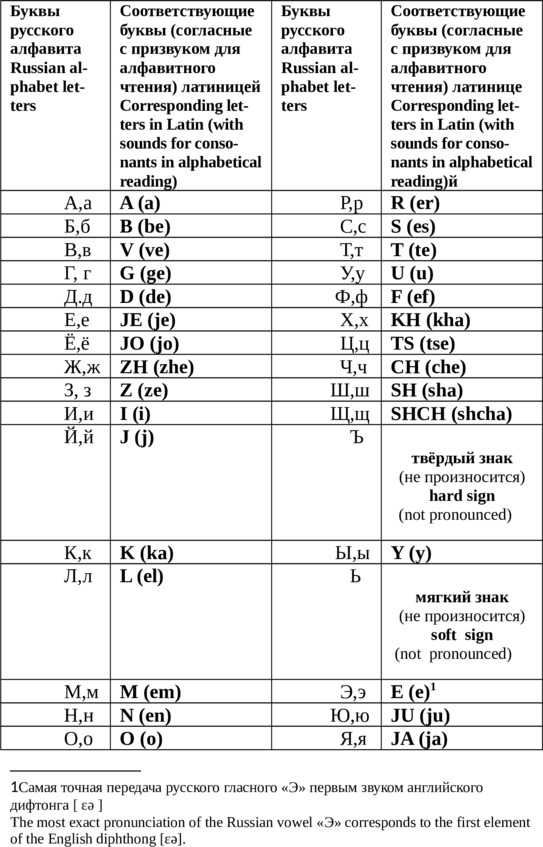

Mind! The consonants are given with an attached vowel only for alphabetic reading. Внимание! У согласных дан гласный призвук алфавитного чтения. Example Пример К (kа)
ИНОГДА В СРАВНЕНИИ ЗВУКОВ РУССКОГО ЯЗЫКА С ОПОРОЙ НА АНГЛИЙСКИЕ СЛОВА ДАЁТСЯ ТАКОЙ ВАРИАНТ.
SOMETIMES, IN COMPARING THE SOUNDS OF THE RUSSIAN LANGUAGE WITH THE SUPPORT OF ENGLISH WORDS, SUCH AN OPTION IS GIVEN.
Таблица 3
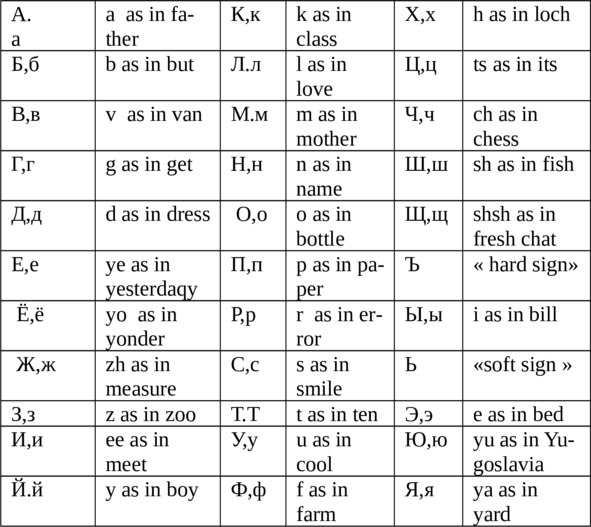
Поэтому автор настоящего учебника настойчиво отсылает к рекомендуемой транскрипции, приведённой автором первой. Она лучше для дифференциации русских звуков при их усвоении.
Therefore, the author of this textbook insists on the first recommended transcription given by the author. It is better for differentiating Russian sounds during their assimilation.
Гласные Vowels
В русском языке 6 гласных с одним звуком:
а [а],о [о], у [у], и [и], ы [ы],э [э]1.
There are 6 vowels in Russian with one sound:
а [а], оо [о], у [у],и [и], ы [ы],э [э].
Гласные буквы, которые обозначают два звука: Я [й’a], Ё [й» o], ю [й’y], Е [й’э].
Vowels with two sounds:
Я [й’a], Ё [й» o], ю [й’y], Е [й’э].
Согласные звуки Consonants
paired —парныеБ В Г Д З Ж voiced звонкиеП Ф К Т С Ш voiceless глухиеnot paired – непарныеЛ М Н Р Й voiced звонкиеХ Ц Ч Щ voiceless глухиеПримечание: Й условно упомянута среди согласных.
Note: Й is conventionally mentioned among the consonants.
Всегда твёрдые согласные Always hard consonants
ж, ш, ц
Всегда мягкие согласные Always soft consonants
ч, щ,
Сонорные Sonorous
Л, М, Н, Р.В русском алфавите 33 буквы, твёрдый Ъ и мягкий Ь знаки не читаются, а влияют на произношение согласных.
The Russian alphabet has 33 letters, the hard sign Ъ and the soft sign Ь are not pronounced but influence on pronunciation of consonants.
Произношение согласных Pronunciation of consonatsСогласные твёрдые Consonants are ronounced as hard (перед before А, О, У, Ы, Э гласными vowels) и мягкие as soft (перед before И, Е, Ё, Ю, Я гласными vowels)
Таблица 4
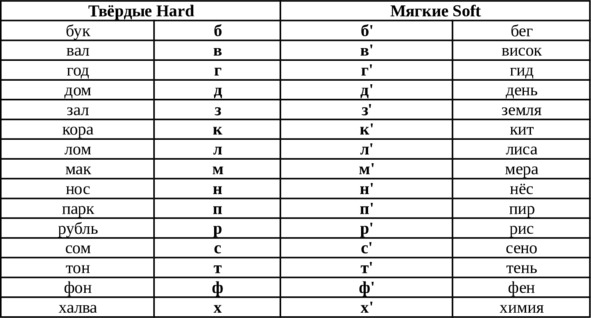
Примечание: знак ‘ вверху у согласной обозначает её мягкость.
Note: The «sign at the top of the consonant indicates its softness.
Примечание о русской транскрипции:
Note about Russian transcription:
1. Буква Й – занимает промежуточное положение между согласными и гласными, поэтому символически лучше выбрать знак [j] из транскрибационных знаков латинской транскрипции, и соответственно так передать четыре русские гласные с двумя звукамиЕ [je], Ё [jo], Ю [ju], Я [ja].
1. The letter Й occupies an intermediate position between consonants and vowels, therefore it is symbolically better to choose the [j] sign from the transcriptional signs of the Latin transcription, and, accordingly, to convey four Russian vowels with two sounds like that Е [je], Ё [jo], Ю [ju], Я [ja].
2. Тогда для Ы остаётся знак [y], а для И – [i], а различие этих гласных с трудом усваиваются носителями другого языка, вернее возникает трудность с их произношением, особенно в конце слов.
2. Then for Ы there remains the sign [y], and for И – [i], and the difference between these vowels is difficult for native speakers of another language, or rather there is a difficulty withpronunciation, especially at the end of words.
3. Транскрибационные латинские знаки ограничены в передаче разницы двух русских гласных Е и Э. Оба передаются знаком [e], лучше бы было использовать для Э первый знак из английского дифтонга [ɛə], тогда ясно различие между Е и Э, второй гласный шире.
3. Latin transcription signs are limited in conveying the difference between two Russian vowels E and Э. Both are conveyed by the [e] sign, it would be better to use the first sign from the English diphthong [ɛə] for Э, then the difference between E and Э is clear, the second vowel is wider.
Примечание: даже в латинской транслитерации русскими тоже встречаются варианты; транскрипция, в основном, нужна для написания русских имён, фамилий и географических названий, но не для запоминания русских слов.
Note: even in Latin transliteration, Russians also have variants; transcription is mainly needed for spelling Russian names, surnames and geographical names, but not for memorizing Russian words.
Таблица 5
Русская транскрипция ///////////////////Зарубежная транскрипция
Russian transcription /////////////////////Foreign transcription
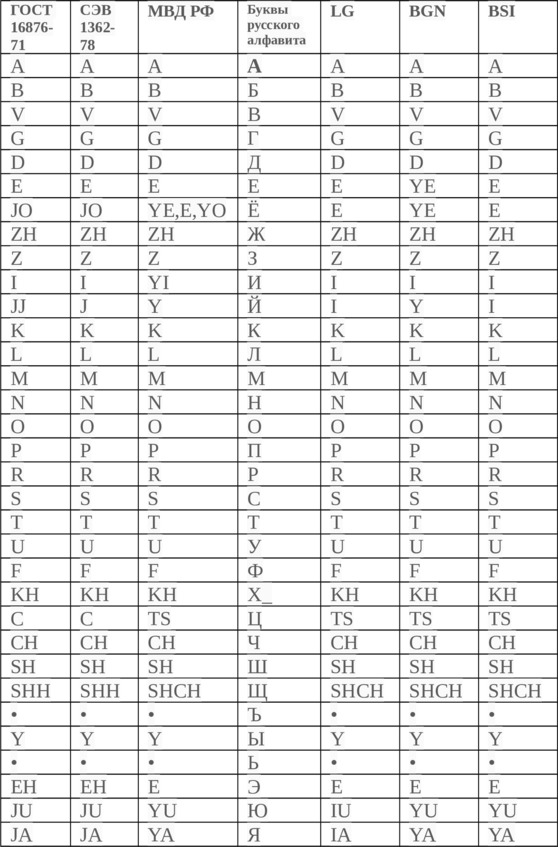
Правописание Ъ и Ь знаков
How to write correctly the sings Ъ and Ь
Ъ
– для отделения гласных to separate the vowels «Е, Ё,Ю,Я»
подъехать, съёжился, предъюбилейный, предъявить, объять, изъян
– для отделения приставок to separate prefixes
панъевропейский, фельдъегерь, двухъярусный, трёхъярусный, четырёхъязычный
– в иностранных словах in foreign words
адъютант, инъекция, субъект
Ь
– в конце слов, чтобы обозначить мягкость согласного
– at the end of words to soften the final consonant
голубь, тетрадь, грязь, семь, жаль, конь
– существительные женского рода in nouns of female gender
рожь, мышь, ночь, печь
– у глаголов in verbs
а) в инфинитиве in infinitive
читать, писать, решать, помогать, мыть, сечь
в инфинитиве также перед возвратной частицей «-ся»in infinitive also before the reflexive particle «-ся»
обжечься, обриться, опозориться
б) у глаголов настоящего времени 2-го лица единственного числа
in verbs of the Present tense 2-nd person singular
ты несёшь, ешь, помогаешь, стираешь, читаешь, делаешь
в) у глаголов простого будущего времени, 2-е лицо единственное число
in verbs of Future tense simple 2-nd person singular
ты пойдёшь, принесёшь, приедешь, поешь, съешь





